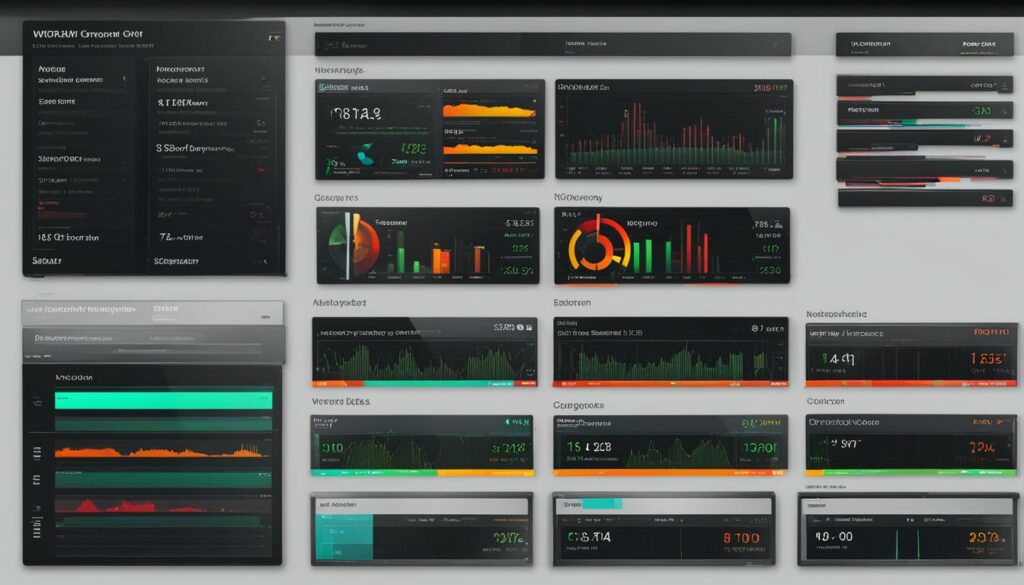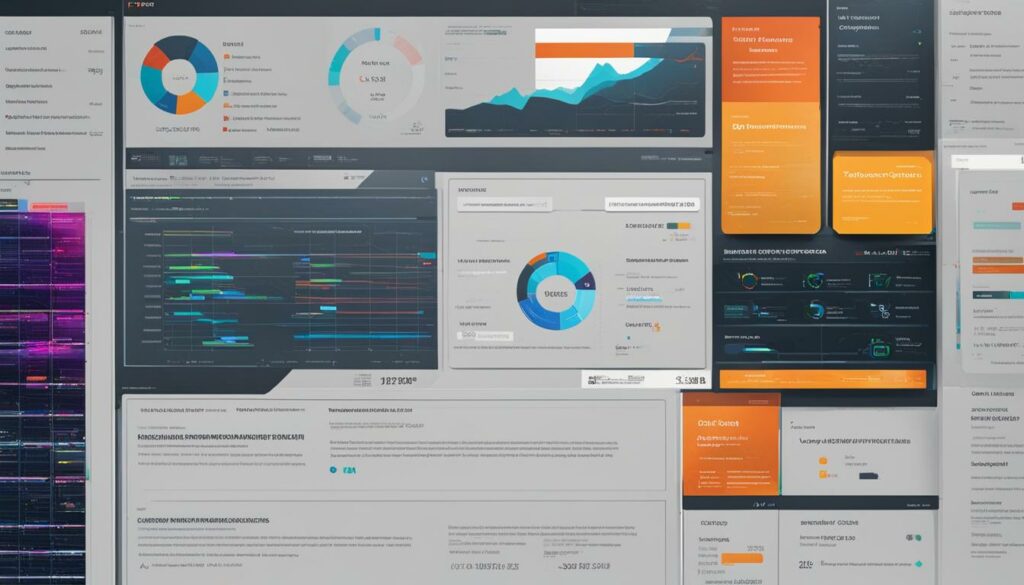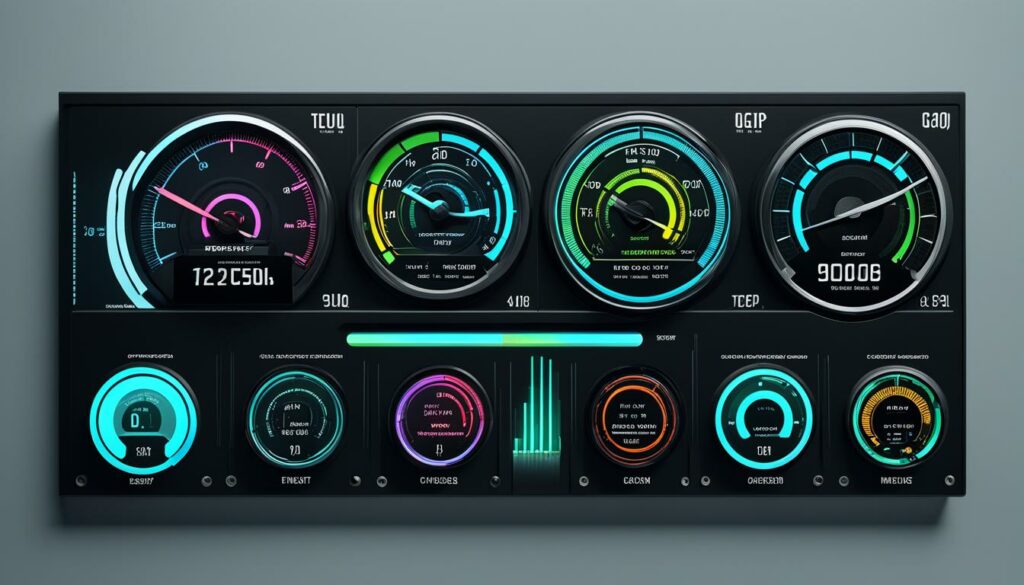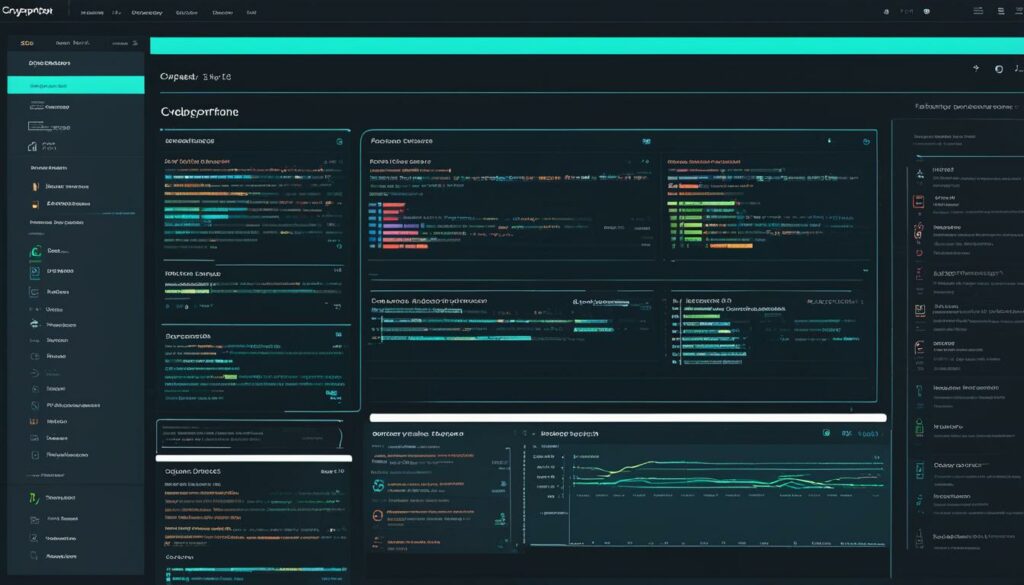Are you looking to optimize your website’s performance and provide a superior user experience? Utilizing performance monitoring tools is essential for web hosting providers like you. These tools track metrics such as page load times, server response times, and error rates to identify performance issues, ensuring your website stays up and running smoothly.
With numerous performance monitoring tools available in the market, it can be overwhelming to find the right one for your needs. That’s why we’ve compiled a list of the top tools that are highly effective in monitoring website performance and optimizing your web hosting services. Let’s dive in!
Key Takeaways:
- Performance monitoring tools are crucial for web hosting providers to ensure optimal website performance and user experience.
- These tools track metrics like page load times, server response times, and error rates to identify and resolve performance issues.
- Choosing the right performance monitoring tool is important for your business’s success.
- Consider factors like uptime monitoring, page load monitoring, and integration options when selecting a tool.
- Regularly monitoring and optimizing website performance leads to improved user satisfaction and increased revenue.
Importance of Website Performance Monitoring
Website performance monitoring is essential for businesses of all sizes to ensure their websites are running smoothly and providing a positive user experience. By tracking various performance metrics, such as page load times, server response times, and user interactions, businesses can identify issues and optimize website performance.
- Application Performance Monitoring: This focuses on monitoring the performance of specific applications or software running on a website. By monitoring application performance, businesses can identify and resolve issues that may impact the overall website performance.
- Network Performance Monitoring: This involves tracking network traffic, latency, and other network-related metrics to ensure optimal connectivity and performance. By monitoring network performance, businesses can identify and address network issues that may affect website performance.
- Performance Testing Tools: These tools are used to simulate user traffic and interactions to assess website performance under different load conditions. By conducting performance tests, businesses can identify potential bottlenecks and optimize website performance to improve the user experience.
Monitoring and optimizing website performance are crucial for maintaining user satisfaction and maximizing business success. It allows businesses to proactively address any performance issues, minimize downtime, and deliver a seamless user experience.
- Identify and resolve performance issues promptly.
- Enhance website speed and responsiveness.
- Improve user experience and engagement.
- Increase customer satisfaction and retention.
- Boost conversion rates and revenue.
Best Practices for Website Performance Monitoring:
To ensure effective website performance monitoring, consider the following best practices:
- Regularly monitor website performance using appropriate monitoring tools.
- Set up customized alerts to receive notifications for performance anomalies and downtime.
- Analyze performance metrics to identify bottlenecks and areas for optimization.
- Optimize website code, images, and content to enhance page load times.
- Utilize caching and content delivery networks (CDNs) to improve website speed.
- Utilize real user monitoring data to gain insights into user behavior and preferences.
Implementing these best practices will help businesses optimize their website performance, provide an exceptional user experience, and drive success in today’s digital landscape.
Popular Performance Monitoring Tools
When it comes to performance monitoring, there are various tools available to help businesses track and optimize their website’s performance. Let’s take a look at one popular tool in this section:
Websiteuptime
Websiteuptime is a simple and dependable performance monitoring software that offers configurable status pages to keep you informed about your website’s uptime. With its user-friendly interface and robust features, it’s an excellent choice for businesses looking to ensure optimal website performance.
Key Features:
- Custom HTTP requests
- Multiple notification handlers
- Project classification
Websiteuptime offers a pricing plan starting at $19 per month, making it an affordable solution for businesses of all sizes.

| Features | Pricing |
|---|---|
| Custom HTTP requests | $19 per month |
| Multiple notification handlers | $19 per month |
| Project classification | $19 per month |
How Performance Monitoring Tools Help Businesses
Performance monitoring tools are invaluable for businesses seeking to optimize their website performance and provide a seamless user experience. By tracking essential metrics such as page load times, server response times, and error rates, these tools enable businesses to identify and address performance issues promptly, ensuring that their website consistently meets user expectations.
Optimizing website performance plays a critical role in enhancing user experience and increasing customer satisfaction. A website that loads quickly, responds promptly, and operates smoothly creates a positive user experience, encouraging visitors to engage with the site and stay longer. When users have a seamless and enjoyable experience, they are more likely to convert into customers or repeat visitors, ultimately driving higher revenue for the business.
Additionally, performance monitoring tools help businesses detect and address performance issues promptly, minimizing their impact on users. By promptly resolving performance issues, businesses can prevent potential revenue loss caused by frustrated users who may abandon the site or seek alternatives. Ensuring consistent website performance not only enhances user experience but also protects the business’s reputation and revenue.
Using a performance monitoring tool allows businesses to proactively track and optimize their website’s performance. This helps them identify bottlenecks, make necessary optimizations, and continuously improve the overall performance of their website. With these tools, businesses can stay ahead of potential issues, provide a seamless user experience, and maximize their revenue potential.
| Benefits of Performance Monitoring Tools | How It Helps Businesses |
|---|---|
| 1. Identifying performance issues | Allows businesses to track metrics and identify areas for improvement in website performance. |
| 2. Proactive resolution | Enables businesses to take proactive measures to resolve performance issues before they impact users. |
| 3. Enhancing user experience | Optimizing website performance leads to improved user experience, higher customer satisfaction, and increased potential for revenue. |
| 4. Minimizing revenue loss | Prompt detection and resolution of performance issues help prevent potential revenue loss caused by frustrated users. |
| 5. Continuous performance improvement | Allows businesses to analyze performance metrics, identify bottlenecks, and make necessary optimizations for ongoing improvement. |
Key Features to Consider
When it comes to choosing the right performance monitoring tool for your business, there are several key features to consider. These features will help you determine which tool aligns best with your specific needs and requirements.
First and foremost, compare the uptime monitoring capabilities of different tools. Uptime monitoring allows you to track the availability of your website and ensures that it is always accessible to users. Look for tools that offer real-time monitoring and instant notifications in case of any downtime.
Another important feature to consider is page load monitoring. This feature tracks the loading time of your web pages and helps you identify any performance bottlenecks. Choose a tool that provides detailed insights into page load times and offers performance recommendations for optimization.
Real user monitoring (RUM) is another valuable feature that you should look for. RUM tracks the actual user experience by collecting data on user interactions and behavior on your website. It provides valuable insights into how users navigate your site, which helps you identify areas for improvement and enhance the overall user experience.
Integration options are crucial for seamless integration with your existing systems and tools. Consider tools that offer easy integration with other monitoring and analytics platforms, such as Google Analytics or New Relic. This allows you to centralize your performance data and gain a comprehensive view of your website’s performance.
Finally, pricing and scalability are important factors to consider. Evaluate the pricing plans of different tools and ensure that they align with your budget. Additionally, consider the scalability options offered by the tool to accommodate potential future growth.
Reading reviews and testimonials from other users can provide valuable insights into the performance, ease of use, and customer support of different performance monitoring tools. Use these reviews to make an informed decision and choose the tool that best suits your business needs.

A visual representation of comparing key features of performance monitoring tools
Best Practices for Website Performance Monitoring
When it comes to website performance monitoring, following best practices is key to ensuring optimal user experience and driving successful performance optimization. By implementing these practices, you can proactively identify and resolve issues, optimize your website’s performance, and gain valuable insights into user behavior and preferences. Here are some best practices to consider:
- Regularly monitor website performance: Conduct regular performance monitoring to ensure your website is running smoothly and efficiently. Monitor metrics such as page load times, server response times, and error rates to identify any performance issues promptly.
- Set up customized alerts: Stay informed about any performance anomalies or downtimes by setting up customized alerts. This way, you’ll receive notifications whenever there is a degradation in performance, allowing you to take immediate action.
- Continuously optimize website performance: Analyze performance metrics to identify bottlenecks and areas where optimizations are required. Whether it’s optimizing code, compressing images, or improving server configurations, consistently work towards enhancing your website’s performance.
- Utilize real user monitoring data: Gain valuable insights into user behavior, preferences, and pain points by leveraging real user monitoring data. This data can help you make informed decisions when it comes to optimizing your website’s design, content, and user experience.
- Regularly review and update your monitoring strategy: As your business objectives and industry standards evolve, it’s essential to regularly review and update your website monitoring strategy. Stay up to date with the latest tools and techniques to ensure your monitoring efforts align with your goals.
By following these best practices, you can ensure that your website performs at its best, providing a seamless user experience and driving business success.

Conclusion
Website performance monitoring is crucial for businesses to ensure optimal website performance and provide a seamless user experience. By utilizing performance monitoring tools, you can track key metrics, optimize your website’s performance, and detect and resolve any performance issues promptly.
To find the right performance monitoring tool for your business, it is important to consider your specific needs and carefully evaluate different options. Compare features, pricing, and scalability options to ensure that the tool aligns with your requirements and budget.
Implementing website performance monitoring best practices will help you continuously improve your website’s performance and drive business success. Regularly monitor your website’s performance, set up customized alerts, and analyze performance metrics to identify and resolve any bottlenecks or issues. Additionally, utilize real user monitoring data to gain insights into user behavior and preferences.
In conclusion, website monitoring is an essential practice to ensure that your website delivers optimal performance to your users. By leveraging performance monitoring tools and following best practices, you can enhance user experience, optimize key metrics, and ultimately drive business growth and success.
FAQ
Q: What are performance monitoring tools?
A: Performance monitoring tools are software programs that track and measure various metrics related to website performance, such as page load times, server response times, and error rates. They help businesses identify performance issues and optimize website performance.
Q: Why is website performance monitoring important?
A: Website performance monitoring is important because it directly impacts user experience and customer satisfaction. By monitoring performance metrics, businesses can detect and resolve issues promptly, ensuring their websites run smoothly and provide a positive user experience.
Q: What is application performance monitoring?
A: Application performance monitoring focuses on monitoring the performance of specific applications or software running on a website. It helps businesses identify bottlenecks, optimize application performance, and provide a seamless user experience.
Q: What is network performance monitoring?
A: Network performance monitoring involves tracking network traffic, latency, and other network-related metrics to ensure optimal connectivity and performance. It helps businesses identify and resolve network issues that may affect website performance.
Q: What are performance testing tools?
A: Performance testing tools are used to simulate user traffic and interactions to assess website performance under different load conditions. They help businesses identify performance bottlenecks and ensure their websites can handle high traffic volumes.
Q: How do performance monitoring tools help businesses?
A: Performance monitoring tools help businesses optimize website performance, improve user experience, increase customer satisfaction, and ultimately drive revenue. They enable businesses to detect and address performance issues promptly, minimizing their impact on users.
Q: What factors should be considered when choosing a performance monitoring tool?
A: When choosing a performance monitoring tool, factors such as uptime monitoring, page load monitoring, real user monitoring, integration options, pricing plans, and scalability should be considered. It’s important to find a tool that aligns with your business needs and budget.
Q: How can businesses optimize website performance?
A: Businesses can optimize website performance by regularly monitoring performance metrics, analyzing data, identifying bottlenecks, and implementing necessary optimizations. Real user monitoring data can also provide insights into user behavior and help drive performance improvements.
Q: What are the best practices for website performance monitoring?
A: Best practices for website performance monitoring include regularly monitoring website performance, setting up customized alerts for downtimes, continuously optimizing performance, and regularly reviewing and updating monitoring strategies and tools.












